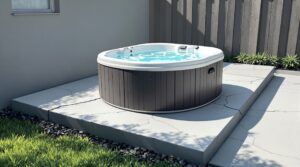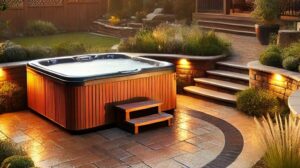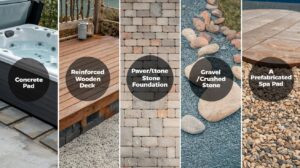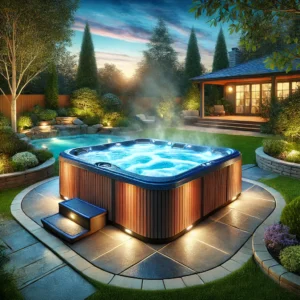Does a Hot Tub Have to Sit on Concrete? An Expert Guide to Choosing the Perfect Base
A hot tub is more than just a luxury amenity—it’s a significant investment in relaxation, wellness, and your home’s outdoor space. One of the most common questions you may encounter is whether your hot tub must sit on concrete. The short answer is no; however, the underlying truth is that your hot tub requires a stable, level, and load-bearing surface. In this comprehensive guide, we’ll explore every facet of hot tub base requirements, compare alternatives to concrete, and walk you through the practical steps to ensure your hot tub is installed safely and attractively.
“A hot tub’s foundation is not about the material itself—it’s about ensuring your investment is supported securely over time.”
— Jacuzzi Installation Guidelines
In the following sections, you will learn about:
- Fundamental structural requirements and why weight distribution is critical
- The advantages and limitations of concrete bases
- Viable alternative foundations including decks, pavers, gravel beds, and prefabricated pads
- A detailed comparative analysis using custom tables and visual diagrams
- Performance factors, step-by-step implementation, troubleshooting, and long-term considerations
- Expert FAQs addressing common queries from beginners to advanced users
By the end of this article, you’ll have the insights needed to choose a base that not only meets local building codes and manufacturer recommendations but also fits your budget and aesthetic preferences. Let’s dive into the world of hot tub foundations and uncover why the focus should always be on stability and safety—regardless of the material.
Installing a hot tub can transform your backyard into a personal retreat, providing endless opportunities for relaxation and social gatherings. However, before you can enjoy the warm, bubbling waters of your new spa, one critical question must be answered: Does a hot tub have to sit on concrete? Many homeowners assume that concrete is the only viable option due to its reputation for durability and stability. While concrete is indeed popular, the true requirement is that your hot tub must be installed on a surface that can support several thousand pounds—taking into account the weight of the empty tub, water, and the people using it.
Consider this: a fully loaded hot tub can weigh upward of 6,000 pounds. Imagine distributing that weight across an unstable or uneven base—this scenario can lead to structural damage, shifting, or even cracking of the hot tub shell. Moreover, a level surface is vital to ensure that water circulation is optimal and that the tub operates as intended. This understanding has led to widespread use of concrete pads; however, several alternatives have emerged over time that can meet the same rigorous standards.


In this guide, we will explore the technical requirements for hot tub foundations, including weight distribution, structural support, and drainage. You’ll gain insight into why concrete is often recommended yet not mandatory, and you will discover alternatives that can be tailored to suit your site’s unique characteristics and your design goals. We’ll provide a detailed breakdown of installation methods, maintenance tips, and even troubleshooting advice if issues arise post-installation.
By the end of this article, you will be equipped with the knowledge to make an informed decision, ensuring that your hot tub not only meets safety standards but also integrates seamlessly with your landscape design. Let’s now explore the foundational concepts that every hot tub owner should know.
Main Topic Exploration
Understanding Hot Tub Weight and Structural Requirements
Before choosing a base, it is essential to grasp the structural requirements a hot tub imposes on its foundation:
- Heavy Load Considerations:
A typical hot tub, when empty, already weighs hundreds of pounds. Once filled with water (approximately 8.34 lbs per gallon) and with several occupants, the total weight can exceed 6,000 pounds. - Even Weight Distribution:
A level surface prevents undue stress on any one area of the tub, reducing the risk of cracks and structural failure. - Load-Bearing Surface:
Whether you choose concrete or an alternative material, the surface must distribute the weight evenly and remain stable over time.
“Weight distribution is not just a number—it’s a guarantee of longevity and safety for your hot tub installation.”
— Bullfrog Spas Technical Manual
The Concrete Advantage
Concrete is the most widely recommended material for hot tub bases, and for good reason:
- Stability and Durability:
A properly poured and reinforced concrete pad provides a rock-solid, level base that minimizes the risk of settling or shifting. - Reinforcement:
Using rebar or wire mesh within a 4- to 6-inch thick slab increases its load-bearing capacity and resistance to cracking. - Maintenance and Longevity:
Concrete is low-maintenance, offering longevity with minimal upkeep. With proper curing and occasional sealing, it stands up to weather extremes and heavy loads.
Exploring Alternative Base Options
While concrete is effective, other surfaces can also provide a stable foundation:
Reinforced Wooden Decks
- Pros:
- Aesthetically pleasing and can integrate with your outdoor living space.
- Elevated design provides easier access.
- Cons:
- Requires professional structural engineering to handle the weight.
- Exposure to moisture demands regular maintenance and sealing.
Paver or Stone Foundations
- Pros:
- Attractive and can be customized for design flair.
- Allows for excellent drainage if installed on a well-prepared base.
- Cons:
- May shift over time if the underlying soil is unstable.
- Requires precise installation and periodic re-leveling.
Gravel Beds or Crushed Stone
- Pros:
- Excellent drainage properties, reducing water pooling under the tub.
- Cost-effective and relatively DIY-friendly.
- Cons:
- Must be compacted thoroughly to avoid settling.
- Weed growth can be an issue without proper maintenance.
Prefabricated Hot Tub Pads
- Pros:
- Easy to install and designed specifically for hot tub applications.
- Often include built-in drainage channels and insulation.
- Cons:
- May not offer the same long-term durability as concrete.
- Weight capacity should be verified for larger models.
“The essence of a good foundation is not in its material but in its ability to support and distribute the weight evenly over time.”
— Happy Hot Tubs Installation Guide
Integrating Manufacturer Guidelines and Local Codes
Adherence to manufacturer recommendations and local building codes is non-negotiable:
- Manufacturer Instructions:
Always refer to the hot tub’s installation manual. Many manufacturers, such as Jacuzzi and Bullfrog Spas, specify certain load requirements and base materials to maintain warranties. - Local Building Codes:
Codes may dictate the type of foundation allowed, especially concerning load distribution and safety margins. Always check with your local authorities before proceeding.
Comparative Analysis
When choosing a hot tub base, comparing options based on key criteria is crucial. Below is a custom table that organizes the pros, cons, and characteristics of different foundation types:
| Base Type | Cost | Durability | Ease of Installation | Drainage | Aesthetic Appeal | Maintenance |
|---|---|---|---|---|---|---|
| Concrete Pad | High ($400-$500+) | High | Moderate (Professional Recommended) | Good (with proper slope) | Neutral (can be enhanced) | Low (minimal upkeep) |
| Reinforced Wooden Deck | Variable | Moderate to High | Moderate (Professional Engineering) | Good | High (integrated design) | Moderate (regular sealing required) |
| Paver or Stone Foundation | Moderate | High | Easy (DIY possible) | Excellent | High (decorative) | Low |
| Gravel or Crushed Stone | Low | Moderate | Moderate (DIY-friendly) | Excellent | Low (rustic look) | Moderate (may need re-leveling) |
| Prefabricated Spa Pad | Low-Moderate | Moderate | Easy | Good | Moderate | Low |

Visualizing the Comparative Factors
Below is an HTML diagram that maps out the interaction between key performance factors for each base option:
This visual representation should help you quickly assess which base best suits your needs based on critical performance factors.
Performance Factors Affecting Hot Tub Base Selection
Several variables influence the success of your hot tub installation:
-
Weight Capacity:
Ensure the chosen base supports both the static (empty tub) and dynamic (filled with water and users) loads. Look for specifications that cover at least 125 pounds per square foot, with many installations exceeding this requirement. -
Levelness:
Even a slight deviation can cause uneven stress. Use a level during installation, and re-check periodically to ensure the base remains flat. -
Drainage Efficiency:
Proper water runoff is essential to avoid water pooling, which can lead to erosion or cracking of the base material. Concrete pads should be sloped slightly (1–2%) to direct water away, while gravel and paver setups naturally encourage drainage. -
Soil Conditions:
The soil beneath your base is as important as the base itself. In areas with soft or clay-rich soil, a wider footprint or additional reinforcement (such as compaction or sub-base stabilization) may be necessary to prevent settling. -
Environmental Exposure:
Consider weather conditions—freeze-thaw cycles can cause concrete to crack, while high humidity may affect wooden decks. Materials must be chosen and treated to resist moisture, UV rays, and extreme temperatures. -
Cost vs. Longevity:
Upfront costs vary dramatically. Although concrete might have a higher initial expense, its long-term durability and low maintenance can offer a better return on investment over time.
“When evaluating performance factors, think of your base as the unsung hero behind years of stress-free relaxation.”
— Roberts Hot Tubs Engineering Insights
Implementation Guide: Step-by-Step Installation Process
Implementing a proper foundation for your hot tub is a process that demands careful planning and execution. Follow these detailed steps to ensure your installation is successful:
-
Site Evaluation & Preparation:
- Assess Soil Conditions:
Have a professional evaluate the soil type and drainage. In areas with soft soil, additional reinforcement may be necessary. - Measure and Mark the Area:
Determine the footprint of your hot tub and add extra space (18–24 inches) around for maintenance access. - Clear and Level the Area:
Remove vegetation, debris, and topsoil. Ensure the area is level using a transit or laser level.
- Assess Soil Conditions:
-
Choosing the Right Base Material:
- Concrete Pad:
Hire a concrete contractor to pour a 4- to 6-inch reinforced slab. Include rebar or wire mesh for additional strength. - Alternative Options:
For a gravel or paver base, excavate 4–6 inches of soil, add a geotextile fabric, and compact crushed stone or sand. For a wooden deck, consult with a structural engineer to design proper support beams and posts.
- Concrete Pad:
-
Installation Process:
- For Concrete:
- Form the outline using wooden forms.
- Pour concrete and integrate reinforcement.
- Smooth the surface and allow it to cure for at least 7 days (ideally 28 days for full strength).
- For Gravel/Pavers:
- Lay and compact a gravel base.
- Install pavers evenly, ensuring each piece is level and secure.
- For Prefabricated Pads:
- Lay the pad on a level, pre-compacted surface.
- Secure the pad if necessary, following manufacturer guidelines.
- For Concrete:
-
Final Inspection & Testing:
- Level Check:
Re-check the surface with a level. - Load Testing:
Before placing the hot tub, test the base with temporary weights to confirm stability. - Accessibility & Drainage:
Ensure that water flows away from the base and that maintenance access is unobstructed.
- Level Check:
-
Professional Consultation:
- Structural Engineer:
For decks or non-traditional bases, seek professional advice. - Hot Tub Dealer:
Follow specific manufacturer instructions to maintain warranties.
- Structural Engineer:
Warning:
Improperly prepared bases can lead to costly damage to your hot tub and potential safety hazards. Always double-check measurements, and when in doubt, consult a professional.
Troubleshooting Common Issues
Even with meticulous planning, issues can arise. Here are some common problems and solutions:
-
Uneven Surface or Settling:
- Diagnosis:
Check for gaps or noticeable shifts in the base. - Solution:
For concrete, minor adjustments may require leveling with a self-leveling compound. For gravel, re-compact the base periodically.
- Diagnosis:
-
Poor Drainage and Water Pooling:
- Diagnosis:
Look for signs of erosion or standing water. - Solution:
Adjust the slope of the base or add drainage channels to ensure water flows away from the hot tub area.
- Diagnosis:
-
Cracking in Concrete Pads:
- Diagnosis:
Inspect for visible cracks or spalling. - Solution:
Use expansion joints in new pours, and repair minor cracks with appropriate fillers. Ensure proper curing and reinforcement during installation.
- Diagnosis:
-
Shifting Pavers or Loose Wooden Deck Boards:
- Diagnosis:
Identify uneven gaps or movement underfoot. - Solution:
Re-set individual pavers and ensure that wooden deck fasteners are secure. Regular maintenance is key.
- Diagnosis:
-
Vibration or Noise from the Hot Tub:
- Diagnosis:
Listen for excessive vibration that might indicate an unstable base. - Solution:
Confirm that the base is level and that there is proper weight distribution. Reinforce with additional supports if needed.
- Diagnosis:
Below is a simple HTML flowchart to help diagnose common issues:
Troubleshooting Flowchart
Issue: Base Instability
- Is the surface level?
- If no: Re-level and re-compact the base.
- If yes: Proceed to check load distribution.
- Is the base cracking or shifting?
- If yes: Inspect reinforcement and drainage.
- If no: Monitor for further changes.
By following these diagnostic steps, you can troubleshoot and address issues early, ensuring a long-lasting foundation for your hot tub.
Innovation and Extended Applications
The world of hot tub installations is continuously evolving. Here are some innovative trends and extended applications:
- Smart Foundations:
Emerging technologies include smart sensors that monitor structural integrity, levelness, and moisture. These devices alert you to potential problems before they escalate. - Eco-Friendly Options:
Recycled materials and sustainable practices are gaining traction. For example, eco-friendly concrete mixes and composite decks made from reclaimed wood are becoming popular. - Modular and Portable Bases:
Prefabricated spa pads and interlocking systems offer portability and ease of installation. These solutions are particularly appealing for renters or seasonal installations. - Aesthetic Enhancements:
Homeowners are integrating LED lighting, decorative stone veneers, and custom paver patterns to elevate the look of their hot tub area. - Multi-Purpose Outdoor Spaces:
Innovative designs combine hot tubs with outdoor kitchens, fire pits, or landscaped patios. This trend underscores the importance of a solid base that integrates with broader design elements.
Connecting your hot tub installation with other outdoor projects not only enhances your living space but can also increase your property’s value. As technology advances, consider future-proofing your foundation with options that can support additional smart home integrations and environmental controls.
Long-term Considerations
When planning your hot tub foundation, think long-term:
- Sustainability:
Choose materials that endure extreme weather and time. Concrete and stone offer longevity, while treated wood and composite decks require periodic upkeep. - Maintenance Requirements:
Regular inspections and minor repairs can prolong the life of your base. For instance, re-sealing a wooden deck or addressing minor concrete cracks early will save you from larger expenses later. - Cost-Benefit Analysis:
Although upfront costs may be higher for concrete, the long-term durability and minimal maintenance often justify the investment. In contrast, cheaper alternatives may require more frequent attention. - Upgrade or Replacement Indicators:
Watch for signs like shifting, cracking, or moisture accumulation. These may indicate it’s time for reinforcement or replacement.
A thoughtful approach to long-term planning ensures your hot tub remains a safe, attractive, and valuable addition to your outdoor space.
Expert FAQ Section
Q1: Is concrete always the safest option for a hot tub base?
A: Concrete is highly recommended due to its strength, durability, and even weight distribution. However, alternatives like reinforced decks or paver bases can be equally safe if engineered correctly and maintained regularly.
Q2: What weight capacity should my base support?
A: Your base should be able to support at least 125 lbs per square foot. For larger hot tubs, plan for a total load exceeding 6,000 pounds. Always refer to the manufacturer’s specifications.
Q3: Can I install a hot tub base on an existing wooden deck?
A: Not without proper reinforcement. Existing decks must be evaluated by a structural engineer to ensure they can handle the dynamic loads of a filled hot tub.
Q4: How does local building code affect my hot tub base installation?
A: Local codes may dictate minimum requirements for load-bearing surfaces and drainage. It’s essential to consult local authorities and obtain permits if necessary.
Q5: What are the maintenance differences between concrete and alternative bases?
A: Concrete generally requires minimal upkeep, whereas wooden decks may need regular sealing and paver bases might need occasional re-leveling. Gravel bases require periodic compaction checks.
Q6: How do weather conditions influence my choice of base?
A: In regions with freeze-thaw cycles, concrete should include proper reinforcement and drainage. In humid areas, moisture-resistant materials like composite decks may be preferable.
Q7: What cost considerations should I keep in mind?
A: Upfront costs for concrete are higher, but its durability often leads to lower long-term maintenance expenses. Cheaper options might save money initially but could incur costs over time due to repairs.
Conclusion
Choosing the right foundation for your hot tub is a decision that blends engineering principles with aesthetic considerations. While concrete remains the gold standard due to its proven stability and durability, alternatives such as reinforced decks, pavers, gravel beds, and prefabricated spa pads are viable options. The key is ensuring that the base is stable, level, and capable of supporting the full weight of your hot tub when in use.
This guide has walked you through the technical requirements, comparative analysis, performance factors, and practical implementation steps required to achieve a safe and long-lasting installation. As you move forward, remember that consulting with professionals—be it a structural engineer or a hot tub dealer—can provide tailored insights for your specific situation.
Your next step? Evaluate your outdoor space, consider your budget and long-term maintenance preferences, and choose a foundation that not only meets code but also enhances your overall design. Enjoy your journey to creating a perfect, safe hot tub oasis!
Additional Resources
- Jacuzzi Official Installation Guides: For manufacturer-specific requirements and best practices.
- Bullfrog Spas Technical Manuals: Detailed insights on weight distribution and maintenance.
- Roberts Hot Tubs Engineering Insights: In-depth technical considerations and expert advice.
- SitePrep & Landscaping Forums: Community-driven tips on soil preparation and base installation.
- Happy Hot Tubs Blog: A mix of DIY projects and professional installations for inspiration.
Technical Glossary
Below is a glossary of uncommon or technical terms used in this guide:
- Curing: The process by which concrete hardens and develops strength over time.
- Expansion Joints: Gaps in concrete that allow for movement and reduce the risk of cracking.
- Geotextile Fabric: A permeable material used to prevent weed growth and stabilize soil.
- Load-Bearing: The capacity of a surface to support weight without structural failure.
- Prefabricated: Pre-made components that are manufactured off-site and assembled during installation.
- Rebar: Reinforcing steel bars embedded in concrete to enhance strength.
- Sub-Base: The layer of material beneath the main base that improves stability and drainage.
- Vibration Resistance: The ability of a material to absorb or reduce oscillations.
- Waterproofing: The process of making a surface resistant to water penetration.
- Wood Composite: Engineered material made from wood fibers and plastic, used for durable decking.
Glossary terms are arranged alphabetically for easy reference.
Key Takeaways
- Stability is Paramount:
Your hot tub must sit on a stable, level, and load-bearing surface—whether that surface is concrete or an alternative material. - Concrete is Common but Not Mandatory:
While concrete is popular for its durability and even weight distribution, other options like reinforced decks, pavers, gravel beds, and prefabricated pads can also be effective. - Local Codes and Manufacturer Guidelines Matter:
Always consult your hot tub’s installation manual and local building codes to ensure compliance and maintain safety. - Maintenance and Long-Term Considerations:
Consider not only the initial cost but also the long-term durability and maintenance requirements of your chosen base. - Plan Ahead with Professional Help:
For complex installations, consult structural engineers or professional installers to customize your solution.
This expert guide is designed to empower you with in-depth knowledge and practical steps to ensure that your hot tub enjoys a safe, secure, and attractive foundation—so you can focus on relaxation and enjoyment for years to come.
What are your thoughts on these options? Feel free to share your feedback or ask for further details on any section!

